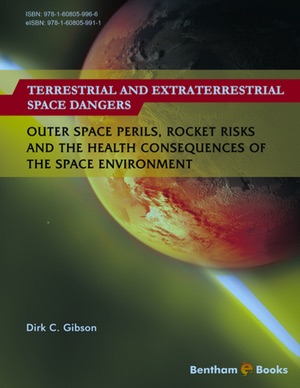Review: Terrestrial and Extraterrestrial Space Dangersby Jeff Foust
|
| It’s pretty clear after reading just the first few chapters that Gibson is in over his head, and doesn’t truly understand the subject matter he’s discussing. |
At first glance, Terrestrial and Extraterrestrial Space Dangers would appear to be a good guide to those issues. Dirk Gibson, a professor of mass communications at the University of New Mexico, examines the various risks posed by space to people in space and on the Earth. He splits those risks into three categories: risks posed by space itself (asteroid impacts, supernovae, etc.), the risks associated with launching into space, and risks to human health from space, including bone and muscle loss and vision issues. He wraps up the book by trying to quantify and categorize the severity of those various risks.
In theory, that approach offers a rigorous analysis of the risks that could inform companies, individuals, and governments. In practice, though, not so much. It’s pretty clear after reading just the first few chapters that Gibson is in over his head, and doesn’t truly understand the subject matter he’s discussing. And it gets no better as you plow through all thirty chapters of the book.
Gibson has clearly done a lot of research, and quotes liberally from those sources: a typical ten-page chapter has about 50 endnotes, although the same sources are often used multiple times in the same chapter. But while there’s plenty of research, there’s little synthesis or analysis of that research, and little sign he is doing anything more than regurgitating quotes from those sources.
That lack of subject matter expertise shows up throughout the book. In addition to a chapter on “near-Earth asteroids and near-Earth objects,” there are chapters on asteroids, meteors, and even centaurs, objects orbiting beyond Saturn that pose very little risk to anyone on or near Earth. (Oddly, he doesn’t give Kuiper Belt or Oort Cloud objects their own chapter or chapters.) The book is also filled with other typos and errors that indicate problems with both its writing and editing.
| “Precisely how many satellites are in orbit around the Earth? In a sense the exact number is unimportant, because the bottom line answer to the question is: A lot.” |
Given those problems, it’s not surprising the analysis of risks in the book’s conclusions is suspect. The “aggregate space risk calculations” is simply another collection of odds from other sources, with no effort to analyze them in such a way that they can be compared with each other. This means giving several “odds of danger” for asteroids, from every 1,200 years to every 300,000 years, without discussing the differences between those odds. (He also gives separate odds for “meteors” and “comets & asteroids.”) He considers near Earth objects a “primary” risk in the book’s final chapter, but meteors a “secondary” risk.
Sometimes the book’s prose is laughably bad. One example: “Precisely how many satellites are in orbit around the Earth? In a sense the exact number is unimportant, because the bottom line answer to the question is: A lot.” A section of another chapter on near Earth asteroids has the heading: “Definition of Earth-Crossing Asteroids.” That section consists of exactly one sentence: “Earth-crossing asteroids are those whose orbit crosses that of the Earth.” Well, at least it’s correct.
A book that analyzes and places into context the various risks associated with spaceflight, and how to communicate those risks to various stakeholders—policymakers, investors, and the public, among others—would be a useful tool, although perhaps not at the inflated price of this book, whose print version is even more expensive. However, Terrestrial and Extraterrestrial Space Dangers is not that book, at any price.
